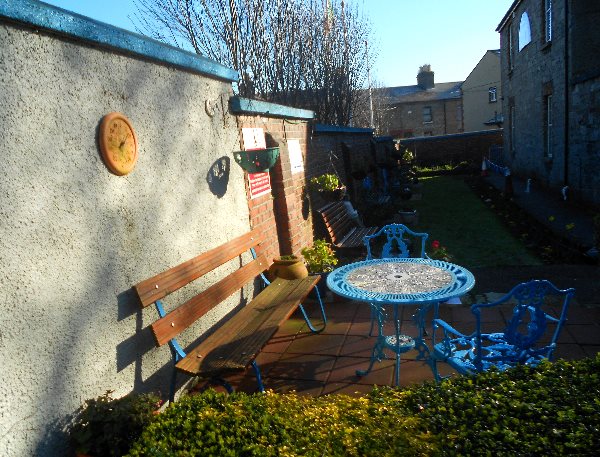Locations that feature in the Irish crime series about Stoneybatter PI Moss Reid...
Tuesday, 1 March 2016
A little patch of (UN) sky blue
The UN memorial garden in Arbour Hill in Dublin will be an early location in the fourth Moss Reid book. A small garden with at least three entrances/exits - one directly onto the street - yet secluded, tranquil and rather special.
It was officially opened by President McAleese in 1998; I guess that for most people who pass through it during the day it's just a charming shortcut between Stoneybatter's backstreets and the green space of Arbour Hill cemetery, whose grounds are often more like a public park, with their many dog-walkers and pram-pushers.
One entrance to the memorial garden is via the terraced streets. The blue metal door with its brass plate in a whitewashed wall on Mount Temple Road is overshadowed by the triangle-shaped park next door.
This triangled street corner has been cobbled and fenced off by railings - painted a UN sky blue - with headstones, a flagpole, a well-groomed tree (a weeping willow?) and a Celtic stone cross. The little park is dedicated to the soldiers and gardai who have died on UN duties.
But there is a second entrance to the memorial garden, not quite directly opposite the first one. It's from the Arbour Hill graveyard: a wooden door built into one of the cemetery's thick stone walls, tucked away at the end of a narrow path in the graveyard's northeast corner.
It takes you through to the little green oasis, walls on all four sides: redbrick, granite, redbrick, redbrick.
A walled garden with a thin, narrow patch of manicured grass and well tended flower beds, early daffodils, a compost corner, hanging baskets, planters, box hedge, metal benches painted the same UN sky blue again (with the letters "UN" in white).
Dotted around the beds and benches are shiny stone spheres, buddhas, garden gnomes, toys, swan statues, a clock-like thermometer, and roughly painted signs for "Leafy Glade".
At one end of the garden is Arbour House, once the living quarters for the caretaker or the master of a nearby school. It's now a heritage centre and the HQ of IUNVA, the Irish United Nations Veterans Association. It leads on to at least one further entrance directly into the graveyard. Somewhere in the warren of buildings is yet another entrance, to Arbour Hill Boxing Club, "a club that everybody [once] feared".
After the buddhas and gnomes, at the opposite end of the garden is a further mix of bizarre bedfellows: a compost corner, a standard wooden picnic bench, and a khaki-green artillery gun. Don't ask me what type*; I don't do guns.
I've never seen anyone having a picnic here, or making compost, or lobbing shells into Stoneybatter from the gun for that matter.
Apart from the buddhas, I've never noticed any religious imagery in the memorial garden. In stark contrast, the graveyard next door is dominated by Christian symbols, from many of its gravestones to the huge golden crucifix on the 1916 Proclamation wall.
Maybe that's the garden's secret: while some of its features are unashamedly military (the large field-gun is impossible to avoid), the garden is far from militaristic or even a particular religion.
It's a quirky, bright, friendly, calm and reflective space - possibly the very opposite of what you might expect.
(* Actually that field gun is a 25 Pounder. A small sign beside it says: "If it was possible to love a gun, this was the gun, genuinely loved and respected by gunners the world over." The 25 Pounder was introduced into service of the British Army in 1939, and introduced in the Irish Defence Forces 10 years later.)










